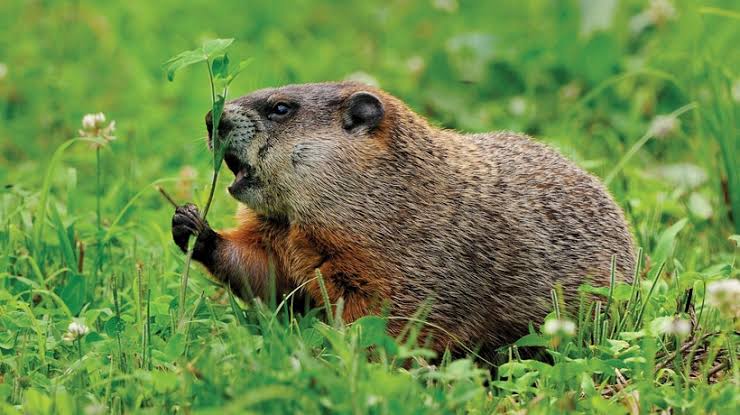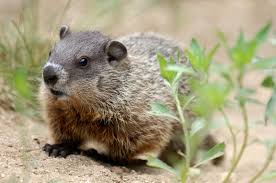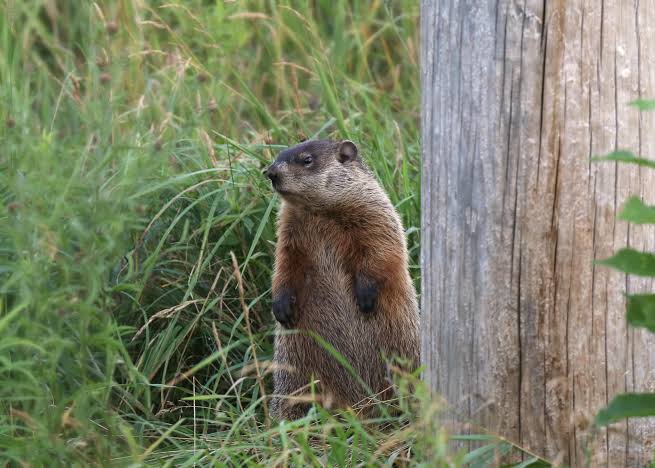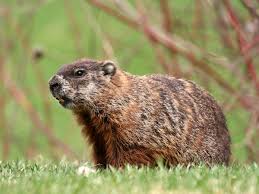Groundhogs, scientifically known as Marmota monax, are fascinating creatures that belong to the marmot family. These furry animals are often called woodchucks in some regions. Groundhogs are widely found in North America, inhabiting areas with open fields, meadows, and woodlands.
Known for their stout bodies and short legs, groundhogs possess a distinctive appearance. Their fur varies in shades of brown and gray, providing them with effective camouflage in their natural habitats. These creatures are renowned for their burrowing skills, creating intricate tunnel systems beneath the ground. These burrows serve as both shelter and a safe space for hibernation during the winter months.
Groundhogs are primarily herbivores, with a diet consisting of plants, fruits, and vegetables. Their strong claws and powerful incisor teeth aid them in digging and foraging for food. Despite their robust build, groundhogs are agile climbers and swimmers, showcasing a versatile range of abilities.
One of the most notable features of groundhogs is their behavior during hibernation. As winter approaches, these animals enter a state of torpor, where their body temperature drops, and metabolic activity significantly decreases. This hibernation allows them to conserve energy during the harsh winter months when food is scarce.
Groundhogs are particularly famous for their role in folklore, especially on Groundhog Day, celebrated on February 2nd in North America. According to tradition, if a groundhog emerges from its burrow on this day and sees its shadow, there will be six more weeks of winter. This quirky tradition has become a cultural phenomenon, with many eagerly awaiting the groundhog’s weather prediction each year.
From their burrowing prowess to their hibernation habits, these animals play a significant role in the ecosystems they inhabit. Groundhogs capture our attention not only through their biological traits but also through their cultural significance, making them a noteworthy species in the animal kingdom.
Read Also: Cornish Rex Cat Breed Description and Complete Care Guide
Plants Affected by Groundhogs (Marmota monax)

Groundhogs, also known as woodchucks, can have an impact on various plants due to their herbivorous nature. These furry creatures may feed on a range of plants, and their foraging habits can sometimes pose challenges for gardeners and farmers.
1. Vegetables: Groundhogs have a penchant for vegetables, and gardens with crops like lettuce, broccoli, carrots, and beans may attract their attention. Their feeding can result in damage to these crops, affecting both the quantity and quality of the harvest.
2. Fruits: Orchards and gardens with fruit-bearing trees or bushes may be susceptible to groundhog interference. Apples, berries, and other fruits become targets for these herbivores, leading to potential losses for fruit growers.
3. Herbs: Groundhogs may also nibble on various herbs such as basil, parsley, and cilantro. For those cultivating herbs for culinary or medicinal purposes, the presence of groundhogs can be a concern.
4. Flowers: Ornamental plants and flowers in gardens may not be spared either. Groundhogs may graze on flower petals and leaves, impacting the aesthetic appeal of landscapes.
5. Grasses: While not their primary food source, groundhogs may consume grasses as well. Lawns and grassy areas can experience damage, particularly in regions with a high groundhog population.
Mitigating the impact of groundhogs on plants often involves implementing protective measures such as fencing or deterrents. Gardeners and farmers may use barriers to prevent groundhogs from accessing their crops, and various repellents can be employed to discourage these animals from feeding on specific plants.
Understanding the types of plants that groundhogs are likely to target is crucial for devising effective strategies to coexist with these animals while minimizing potential damage to valuable crops and vegetation.
Damages Caused by Groundhogs

Groundhogs, with their burrowing and herbivorous habits, can cause various damages in different settings, ranging from agricultural areas to residential properties. Here are some of the key damages caused by groundhogs:
1. Burrow Damage: Groundhogs are skilled diggers and create extensive burrow systems. While these burrows provide shelter for groundhogs, they can be problematic for property owners. The burrows may undermine foundations, damage fences, and create tripping hazards in fields or yards.
2. Crop Damage: Groundhogs are herbivores, and their feeding habits can lead to significant damage to crops. Gardens, farms, and orchards are susceptible to groundhog foraging, resulting in reduced crop yields and economic losses for agricultural producers.
3. Garden Damage: Home gardeners often face challenges when groundhogs discover their vegetable patches. Groundhogs can devour a variety of garden plants, including vegetables, fruits, and herbs, causing frustration and impacting the efforts of those cultivating their own produce.
4. Landscape Damage: Groundhogs may also damage ornamental plants and flowers in residential landscapes. Their feeding on flowers and shrubs can compromise the aesthetic appeal of gardens and lawns.
5. Tunneling Understructures: The extensive burrow systems created by groundhogs may extend beneath sheds, decks, or other structures. This tunneling can weaken the stability of these structures over time, leading to potential safety hazards.
6. Erosion: In areas with high groundhog populations, their burrows can contribute to soil erosion. The removal of vegetation around burrow entrances can leave the soil exposed, making it susceptible to erosion during heavy rains.
To address these damages, property owners often employ various methods to deter groundhogs. Protective fencing, trapping, and the use of repellents are common strategies to minimize the impact of groundhog activities. It’s essential to strike a balance between coexisting with wildlife and protecting property and crops from the potential damages caused by groundhogs.
Read Also: Birman Cat Breed Description and Complete Care Guide
Control and Preventive Measures

Controlling and preventing groundhog-related issues involves a combination of strategies to deter these animals from causing damage. Here are some effective measures:
1. Fencing: Erecting a sturdy fence around vulnerable areas can be an effective way to keep groundhogs out. Use materials like hardware cloth or chicken wire, burying a portion underground to deter digging. Ensure the fence is tall enough to prevent climbing.
2. Repellents: Various commercial repellents are available that emit scents or tastes unpleasant to groundhogs. Applying these around garden beds, crops, or targeted areas can discourage them from feeding. However, effectiveness may vary, and reapplication may be necessary.
3. Trapping: Live trapping is another option for control. Traps baited with vegetables can capture groundhogs, allowing for relocation to a more suitable habitat. It’s important to check local regulations regarding trapping and relocating wildlife.
4. Natural Predators:.Encouraging the presence of natural groundhog predators, such as foxes, owls, or domesticated pets, can help control groundhog populations. This may involve creating habitats or providing shelter for these predators.
5. Habitat Modification: Modify the landscape to make it less appealing to groundhogs. Remove sources of food, secure garbage cans, and eliminate tall grass or dense vegetation where groundhogs may feel protected.
6. Fill and Seal Burrows: If groundhogs have already established burrows in undesirable locations, filling and sealing the entrances can prevent further use. Be cautious during this process to avoid harming any animals inside.
7. Use of Noise and Vibrations: Groundhogs can be sensitive to noises and vibrations. Devices emitting ultrasonic sounds or ground vibrations can be installed to create an uncomfortable environment, deterring them from staying in the area.
8. Plant Selection: Choose plants that are less appealing to groundhogs. Research plants that are known to be less attractive to them and incorporate them into landscaping or gardening.
9. Regular Monitoring: Keep a watchful eye on your property, especially during seasons when groundhogs are more active. Early detection of groundhog activities allows for prompt intervention and minimizes potential damages.
Implementing a combination of these measures, tailored to your specific situation, can help control groundhog-related issues and prevent further damage to crops, gardens, and property.
Frequently Asked Questions (FAQs) About Groundhogs (Marmota monax)
1. Q: What is the scientific name for groundhogs?
A: The scientific name for groundhogs is Marmota monax.
2. Q: Why are groundhogs also called woodchucks?
A: The name “woodchuck” is thought to have originated from a Native American Algonquian word, possibly “wuchak.” It has no connection to wood or chucking wood; it’s a linguistic evolution.
3. Q: Do groundhogs hibernate?
A: Yes, groundhogs hibernate during the winter months. They enter a state of torpor, reducing their body temperature and metabolic activity.
4. Q: When is Groundhog Day, and why is it celebrated?
A: Groundhog Day is celebrated on February 2nd. It is believed that if a groundhog emerges from its burrow and sees its shadow, there will be six more weeks of winter. The tradition is associated with weather predictions.
5. Q: What do groundhogs eat?
A: Groundhogs are herbivores. Their diet includes a variety of plants, fruits, and vegetables. They particularly enjoy crops like lettuce, broccoli, carrots, and berries.
6. Q: How can I protect my garden from groundhogs?
A: Protective measures include installing fences, using repellents, trapping, and selecting plants that are less appealing to groundhogs. Regular monitoring of your garden is also crucial.
7. Q: Are groundhogs dangerous to humans?
A: Groundhogs are generally not aggressive towards humans. However, they can carry diseases, and their burrows may pose tripping hazards. It’s advisable to maintain a safe distance and address potential issues promptly.
8. Q: Can groundhogs swim and climb?
A: Yes, groundhogs are capable swimmers and climbers. They exhibit agility in various terrains, which adds to their adaptability in different environments.
9. Q: Do groundhogs have natural predators?
A: Yes, groundhogs have natural predators, including foxes, owls, and domesticated pets. Encouraging the presence of these predators can help control groundhog populations.
10. Q: Is it legal to trap and relocate groundhogs?
A: The legality of trapping and relocating groundhogs varies by location. It’s important to check local wildlife regulations and follow ethical practices if considering trapping as a control measure.
Read Also: 5 Ways to Make Money Online this Year

